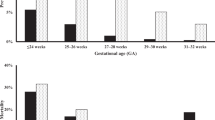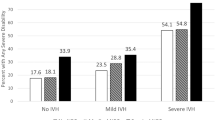Abstract
Objective:
Necrotizing enterocolitis (NEC) is associated with a significant morbidity and mortality in premature infants. We sought to identify the frequency of NEC in very-low-birth-weight infants with isolated ventricular septal defects (VSDs) or atrial septal defects (ASDs) using a large multicenter database.
Study design:
We identified a cohort of infants with birth weight <1500 g cared for in 312 neonatal intensive care units (NICUs) managed by the Pediatrix Medical Group between 1997 and 2010. We examined the association between the presence of an ASD or a VSD with development of NEC using logistic regression to control for small-for-gestational age status, antenatal steroid use, antenatal antibiotic use, gestational age, sex, race, Apgar score at 5 min and method of delivery.
Result:
Of the 98 523 infants who met inclusion criteria, 1904 (1.9%) had an ASD, 1943 (2.0%) had a VSD and 146 (0.1%) had both. The incidence of NEC was 6.2% in infants without septal defects, 9.3% in those with an ASD, 7.8% in those with a VSD, and 10.3% in infants with both an ASD and a VSD. Compared with infants without septal defects, the adjusted odds ratios for developing NEC for each group—ASD alone, VSD alone and ASD with VSD—were 1.26 (95% confidence interval 1.07 to 1.49), 1.27 (1.07 to 1.51) and 1.79 (1.03 to 3.12), respectively.
Conclusion:
The presence of an ASD or a VSD was associated with NEC in this cohort of premature infants.
This is a preview of subscription content, access via your institution
Access options
Subscribe to this journal
Receive 12 print issues and online access
$259.00 per year
only $21.58 per issue
Buy this article
- Purchase on Springer Link
- Instant access to full article PDF
Prices may be subject to local taxes which are calculated during checkout

Similar content being viewed by others
References
Neu J, Walker WA . Necrotizing enterocolitis. N Engl J Med 2011; 364: 255–264.
Guthrie SO, Gordon PV, Thomas V, Thorp JA, Peabody J, Clark RH . Necrotizing enterocolitis among neonates in the United States. J Perinatol 2003; 23: 278–285.
Luig M, Lui K . Epidemiology of necrotizing enterocoliti—Part I: Changing regional trends in extremely preterm infants over 14 years. J Paediatr Child Health 2005; 41: 169–173.
Llanos AR, Moss ME, Pinzon MC, Dye T, Sinkin RA, Kendig JW . Epidemiology of neonatal necrotising enterocolitis: a population-based study. Paediatr Perinat Epidemiol 2002; 16: 342–349.
Holman RC, Stoll BJ, Curns AT, Yorita KL, Steiner CA, Schonberger LB . Necrotising enterocolitis hospitalisations among neonates in the United States. Paediatr Perinat Epidemiol 2006; 20: 498–506.
Lin PW, Stoll BJ . Necrotising enterocolitis. Lancet 2006; 368: 1271–1283.
Henry MC, Moss RL . Neonatal necrotizing enterocolitis. Semin Pediatr Surg 2008; 17: 98–109.
Neu J, Mihatsch W . Recent developments in necrotizing enterocolitis. J Parenter Enteral Nutr 2012; 36 (1 Suppl): 30S–35S.
McElhinney DB, Hedrick HL, Bush DM, Pereira GR, Stafford PW, Gaynor JW et al. Necrotizing enterocolitis in neonates with congenital heart disease: risk factors and outcomes. Pediatrics 2000; 106: 1080–1087.
Bolisetty S, Lui K, Oei J, Wojtulewicz J . A regional study of underlying congenital diseases in term neonates with necrotizing enterocolitis. Acta Paediatr 2000; 89: 1226–1230.
van der Linde D, Konings EE, Slager MA, Witsenburg M, Helbing WA, Takkenberg JJ et al. Birth prevalence of congenital heart disease worldwide: a systematic review and meta-analysis. J Am Coll Cardiol 2011; 58: 2241–2247.
Mukherjee D, Zhang Y, Chang DC, Vricella LA, Brenner JI, Abdullah F . Outcomes analysis of necrotizing enterocolitis within 11 958 neonates undergoing cardiac surgical procedures. Arch Surg 2010; 145: 389–392.
Cheng W, Leung MP, Tam PK . Surgical intervention in necrotizing enterocolitis in neonates with symptomatic congenital heart disease. Pediatr Surg Int 1999; 15: 492–495.
Giannone PJ, Luce WA, Nankervis CA, Hoffman TM, Wold LE . Necrotizing enterocolitis in neonates with congenital heart disease. Life Sci 2008; 82 (7-8): 341–347.
Carlo WF, Kimball TR, Michelfelder EC, Border WL . Persistent diastolic flow reversal in abdominal aortic Doppler-flow profiles is associated with an increased risk of necrotizing enterocolitis in term infants with congenital heart disease. Pediatrics 2007; 119: 330–335.
Murdoch EM, Sinha AK, Shanmugalingam ST, Smith GC, Kempley ST . Doppler flow velocimetry in the superior mesenteric artery on the first day of life in preterm infants and the risk of neonatal necrotizing enterocolitis. Pediatrics 2006; 118: 1999–2003.
Hoffman JI, Kaplan S . The incidence of congenital heart disease. J Am Coll Cardiol 2002; 39: 1890–1900.
Author information
Authors and Affiliations
Corresponding author
Ethics declarations
Competing interests
Dr Benjamin receives support from the United States government for his work in pediatric and neonatal clinical pharmacology (1R01HD057956-05, 1K24HD058735-05 and NICHD contract HHSN275201000003I) and the non-profit organization Thrasher Research Fund for his work in neonatal candidiasis (www.thrasherresearch.org); he also receives research support from industry for neonatal and pediatric drug development (www.dcri.duke.edu/research/coi.jsp). Dr Smith receives salary support for research from the National Institutes of Health and the US Department of Health and Human Services (NICHD 1K23HD060040-01, DHHS-1R18AE000028-01 and HHSN267200700051C); he also receives research support from industry for neonatal and pediatric drug development (www.dcri.duke.edu/research/coi.jsp). The other authors declare no conflict of interest.
Rights and permissions
About this article
Cite this article
Bain, J., Benjamin, D., Hornik, C. et al. Risk of necrotizing enterocolitis in very-low-birth-weight infants with isolated atrial and ventricular septal defects. J Perinatol 34, 319–321 (2014). https://doi.org/10.1038/jp.2013.174
Received:
Revised:
Accepted:
Published:
Issue Date:
DOI: https://doi.org/10.1038/jp.2013.174
Keywords
This article is cited by
-
Necrotizing Enterocolitis in Children with Congenital Heart Disease: A Literature Review
Pediatric Cardiology (2021)
-
The association of congenital heart disease with necrotizing enterocolitis in preterm infants: a birth cohort study
Journal of Perinatology (2015)



